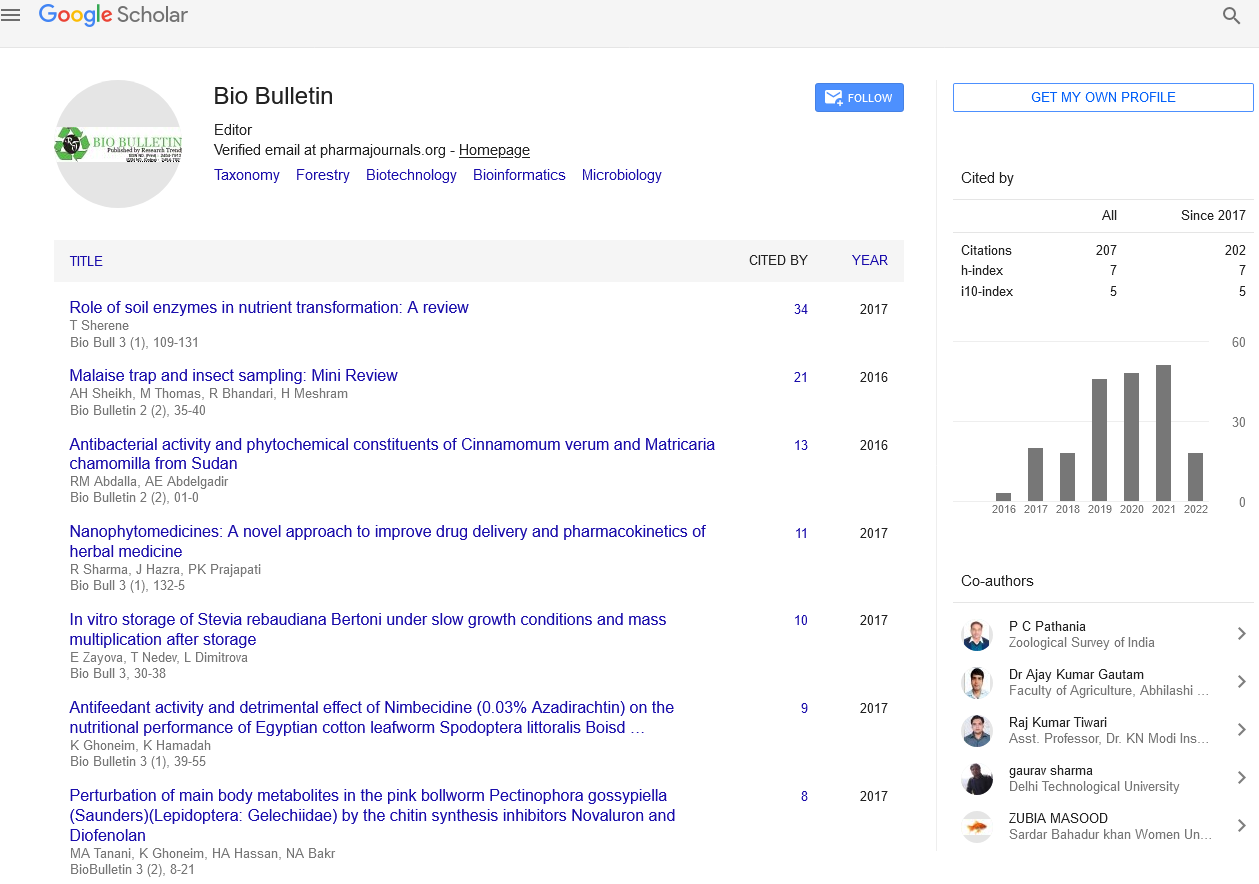Variability of Tropical Pollination
Editorial - (2021) Volume 7, Issue 4
Editorial Note
The fast decline in biodiversity currently underway has been called the sixth mass extinction. The loss encompasses not only individual species, but also ecological interactions, often at a higher rate. Since many key functional aspects and services important for the maintenance of natural biomes and human subsistence depend on biotic interactions, species interactions should be treated as a major component determining the health of ecosystems. For example, plant-animal mutualistic networks, such as pollination and seed dispersal, sustain terrestrial biodiversity and human food security. However, pollinating insects are declining in many parts of the world because of human disturbances, especially habitat loss, but also landscape simplification, population subdivision, and consequent changes in behavior and in interspecific interactions. The value of ecosystem services provided globally by pollinating insects is estimated to be around 7% of the total of agricultural food production. Around 70% of the 124 main crops consumed by humans depend on animal pollinators, and so do most flowering plant species in the wild, especially in the tropics.
Because no species is an island, effective conservation action must protect not only individual species, but the functioning of the whole ecological community, easily represented by the web of interspecies interactions. This focus on relationships or interactions is at the heart of Ecology as a science, and it is therefore not surprising that network tools and concepts have a long tradition in ecological studies. In fact, network ecology is a large and rapidly growing subfield within the discipline. Studies dealing with species interaction networks often rely on biological survey data, sometimes originally obtained with different goals in mind. These data typically suffer from observation errors, incomplete and biased sampling, particularly when dealing with large geographic extents and species-rich systems. Network inference techniques developed in the domain of Network Science can help in the reconstruction of incomplete data, allowing us to capture patterns at a large scale, gain further insight into ecosystem functioning, and hopefully build better conservation strategies.
In this study, we sought to construct local plantpollinator networks across a highly impacted tropical rainforest habitat; examine some structural network properties; and explore how network structure relates to natural forest cover and land cover heterogeneity. For this, we used a database on plant -insect flower visitor interactions from the Atlantic Series data papers collection. We hypothesize that the number of species, number of links, sum and evenness of link weights, connectance and modularity will increase with forest cover, while nestedness and centralization will decrease.
There are two cases in which forest-spp and all-spp networks show opposite results, both involving only very weak correlations. First, modularity seems to decrease with forest cover for all-spp and increase for forest-spp networks. We should however keep in mind that, for forest-spp, modularity was more associated with HLC than with forest cover. Secondly, SLW in function of HLC decreases for all-spp, but increases for forest-spp. That is, in homogeneous sites, networks of forest species have weaker links, and networks of all-spp have stronger links. It is interesting to note that most homogeneous sites in the study area are occupied by agriculture rather than forest.
Author Info
Sangeetha Krishna* and Satya MansiReceived: 15-Oct-2021 Accepted: 29-Oct-2021
Copyright:
icsatc neodeme advancedstructurescorp floormachinebrush scpe jcamasonry sages-tunisie sbsteel technomailleplus bolkan vaalea nsblueprinting mycleanairdoctors nycgeneralproroofing gabgadgets prsnekkern uniquescaffoldingsystems villaguicciardini acerpackaging acjstucco prontointervento-multiservice printersupplygiant sarel takkatiimi dragonshollow mazelsupply alfalchetto reliablegeneralagency lckenterprises realizzazione-giardini dmcindustries shop chathambrass ilfaroservizi soilmechanicsdrilling colorfullyyours agcsound carriere carnavaldetournai falconauto codingxcamp davinci-trondheim thebestofcolumbia cooperativetissage outsourcedmarketingpros tlc dawnnhough doubleclick pdirealty hattrennet az-bizsolutions jamaistropdart frontdata unitycreations fortisarezzo bspo-ken codar-confection theboulders bakerpersonnel fantasyphotographyandvideo fuleky tanssikoulutria ladybi swimanddance scuolavelatoscana x-pack creativeglazing lucagnizio sigaretteelettronichepisa mayiindustries frigo-clim elgars leoemma hotelalcantara el-pro therefore thebestofjacksonville nykran masmoudi thebestofspokane cogepre detrecruitment laresidencelepartage chimneycompanyboston awarepedia res-botanica recipefy semap thebestofcincinnati bb-one fourtech thebestofjoliet ajproduce jerryshulmanproduceshipper lckcabinetryny drivingtechniquesmadeeasy accademiaestetica pizzamaison schoonheidssalonbianca cabinsbrevardnc mrbrushes atlasrolloff hatip-medikal vezcocorporation thebestofcoloradosprings filtaclean monteleeper flyfisher ellatafa associazionepugliesiapisa unitycreationsltd maketeamstudiot douglasclear packagingpro softm allstarbeerinc burtonsupply footballscouting profondacreation johnvravickddsms fireislandbuilder advancedcontrolsolutions chittorgarhtaxiservices live-now orologeriatoscana racinemode thebestofwilmington agro-services violiner sandinghouse the-complete-package thebestofrichmond rcollision meubleskarray mes-recettes lawsandtaxes tavgrupp mkproducts royscottmarine taxi contreras-stockman sigmaweb de-noord thebestofkansascity maisonmedicaledelaeken recycledrubberpavers surfacingsystems unitedfidelityinc enokplan hunterremodeling edmersupply amerequipint sanilabcorp igglesis christiannursingregistry united-royal cantodelfiume northsidedeliny menuiserie-delbart passeritartufi justmyvoice ablefiresprinklers accantoalcentro ckperformance khalfallahpneus anti-flood-barriers bmstyle autosangiorgio-mercedes-benz carmagnino viipurinurheilijat multipack cma-eng mcafeerealty adrianaperciballi loconteedilecostruzioni konarprecision unityrubberco unityrubberproducts dante tela marathongranite baltimahalworcester heimdalbygg alstateprocessservice italydreamtour wemcocastingllc yachtbritesigns ecoledecroly-renaix anchorseniorapartments royalburton sk-veilag giannacapoti hubiteg customcommercialconstruction edm-nivelles probat-tunisie bachlawyer robertex inbora gpbconstruction tekstschrijver-tim bdsit trepro himalayanlounge lazersharpplumbing nycollisionking marinanova gealcorp nygabe maritimecoverage justmyvoice jukumech quimicolsa hayat-med aldrovandiauto michaelbenaltinc korenas sandvet americanmufflerautorepair justmyvoice liacoustics dminteriors agenziapromotech ligbtour internormfirenze justmyvoice zouila kohalmiferenc ashgroveresort ilmacinapepe suzukibandit hihna islandfishli prontointerventofabbro24h thebestofmidland thebestofportland dsgnaturaeambiente rimpex-medical giadaguidi royalroseappliances normas monicavignoliniluxury reddalsand defigners projektorilamput qtbservices labandas totalconceptdesign elannonnayttamo begmaterialiedili bardsdans samuelmanndds marksmenmfg demo17 chinafinewines coralia ivar-moe tournailesbains consew luisaprofumeriashop chimneycompanywestchester danapoly 268dental uspaerospace melonerp matcoservice emperorsoft cantare fninc greenpowerchemical westendsupply domobios unitysurfacingsystems martemoen hamptonssepticservices housatonicpaper sj-transport epsl-tunisie sungoldabrasives collinscreative barbarottomachinery soep thebestofalexandria straightlineconst itcimpianti hattrem-trafikkskole federalnetworks ppattorneys ceteau fbperformance coltgateway coolservice4u garaconfection bellformalwear abcconcretepumping mysantaria accurateindustrialmachining schmugerhardware thebestofjackson bellwetherstaffing sweetkarmadesserts tonerhuset mongilschool polycliniquelaouani buonidentro schoolbusmirrorsonline qlstransportation andereuropa cleanpressiondrycleaner bsyd planetlimony thebestoflasvegas csgmfoodequip potensial potiez invitiing tomscorvetteshop thebestbaltimorebusinesses honefoss thebestofoakland hydeparkdenim scmanndds sirreal totalpreferredsupply futureshockcorp myrtun

